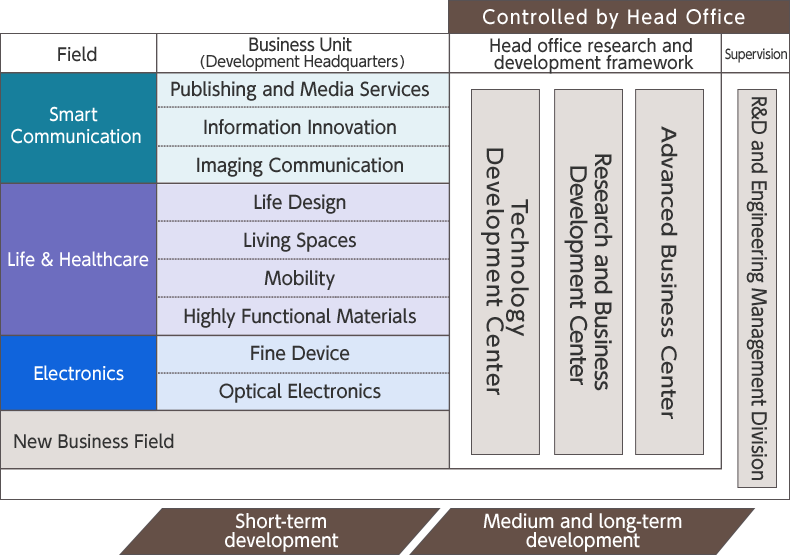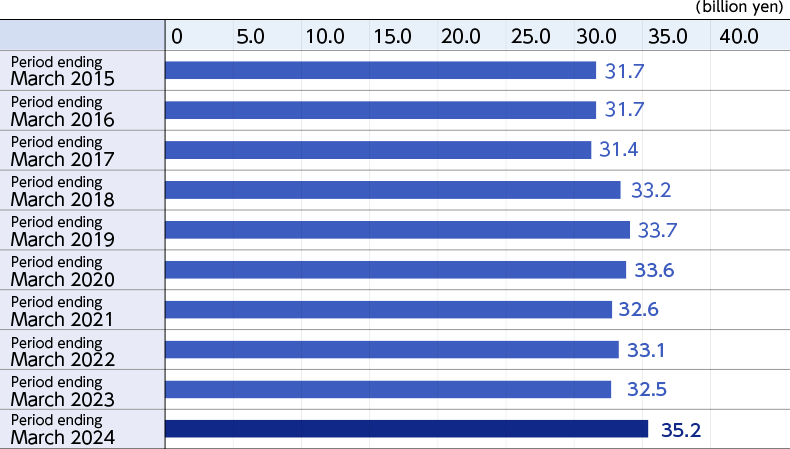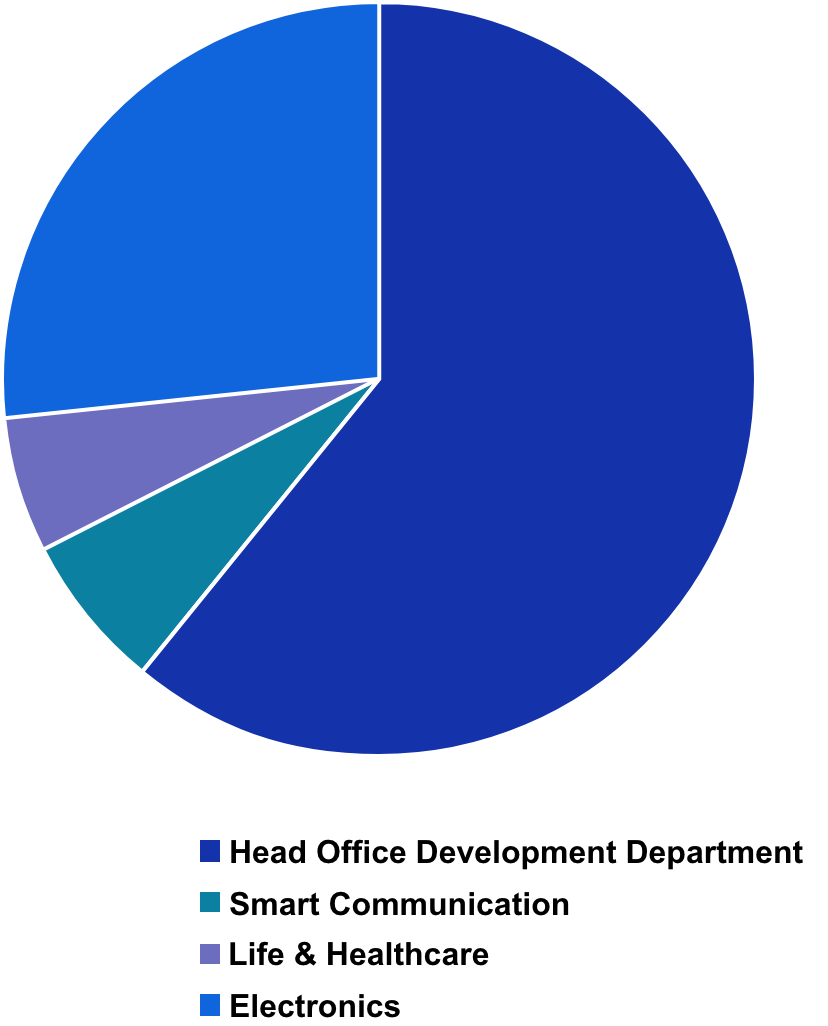R&D Policy and Structure
R&D is important for DNP, and we have expanded our business domains through the applied development of printing and information technologies. In this era of rapid change, we need to think from the perspective of consumers, closely examine social trends and quickly determine what issues exist, and what technologies will be required to solve them. Based on this information, we develop proprietary technologies and collaborate with other companies that have their own unique strengths, resulting in increased speed of our own technological development.
R&D policies
Our R&D policy is to envision a better future and enhance our proprietary technologies to develop and provide new products and services, realizing future scenarios that takes this vision of a better future as its starting point.
We will continue to refine our state-of-the-art microfabrication, precision coating and post-processing technologies, which form the foundation of our manufacturing, alongside our planning and design, information processing, materials development, and evaluation and analysis technologies. We will create new value by synergizing these technologies with expertise from our sales, planning, manufacturing and other divisions, as well with our partners’ strengths.
In particular, with the increasing adoption of DX, we will leverage DNP's unique hybrid strengths in the analog and digital fields, real and virtual domains, and manufacturing and services areas, to create business models based on a better sustainable society and more comfortable lifestyles.

Strengthening DNP's technologies and R&D, and creating new value
For DNP, which has expanded its business domains by applying and developing technologies cultivated in the printing process, strengthening technology and R&D is a crucial management issue. We will always take the consumer’s point of view as we accurately understand environmental, social and economic issues, and create optimal solutions.
DNP will further evolve and deepen the already-strong technologies that we have cultivated to handle, in a safe and secure manner, important information entrusted to us by companies, organizations and consumers, and will also accelerate development by promoting collaboration with various partners, including venture companies, start-ups, universities and research institutions, and by exploring new technologies. Also, we will combine our internal and external technological strengths to solve various problems and create new value that excites people.
R&D is important for this. To increase the efficiency of R&D, we will actively introduce machine learning and generative AI. Materials informatics (MI) has already been introduced in the design of materials which is a part of our R&D efforts.

Creation of new businesses in focus business areas capturing megatrends and business opportunities
DNP promotes the reform of its business structure and pursues the generation of more profits from its business activities through concentrated investments in focus business areas. We also strengthen our cooperation with partners that have strengths different from those of DNP as we advance strategies for obtaining the no. 1 position in many different businesses.
Examples of initiatives
In the medical & healthcare business, CMIC CMO Co., Ltd., for example, became a consolidated subsidiary in May 2023. In June of the same year, we joined the CMIC Group to engage in consistent manufacturing from API to formulation and the development of value-added pharmaceuticals, among other activities.
DNP has also been working on the research and development of efficient cell cultures. In 2017, it became the first company in the world to successfully grow miniature intestinal organoids from human embryonic stem cells (ES cells) and iPS cells (induced pluripotent stem cells) in a test tube in collaboration with the National Center for Child Health and Development. Currently we are selling the miniature intestinal organoids on a trial basis. In June 2024, we teamed up with NEXEL Co., Ltd., a Korean biotechnology company specializing in iPS cells, to commence technical collaboration in the area of cardiomyocyte cultures derived from human iPS cells. Through this collaboration, we will seek to develop a method for manufacturing large quantities of high-quality cells for use in the research and development of new drugs, and a microphysiological system (MPS) simulating human organs on a chip.

R&D structures
DNP's technology and R&D division, centered on the three segments of Smart Communication, Life & Healthcare, and Electronics, is developing proprietary technologies that will create solutions to diverse issues in a wide range of fields. We are building and operating a robust business structure that creates new value in both existing and new areas by promoting synergizing the technology and collaboration with external partners.

Research and Business Development Center
We promote research and development on new products and production processes from a medium- to long-term perspective, alongside business development that solves customer and social issues.
Research and Business Development Center
Advanced Business Center
DNP creates new businesses and DX through digital technologies that support businesses in the information and services sector.
Technology Development Center
Through the development of production and assessment technologies, we support the development of new products and services as well as QCD innovations that increase the value of existing products and services.
Technology Development Center
Developer interviews
Discover the behind-the-scenes efforts of developers who have achieved breakthroughs in a wide range of business fields.
R&D Expenses / Allocation
DNP continues to invest over 30 billion yen annually in technology and R&D, with the amount reaching 35.2 billion yen in the fiscal year ended March 31, 2024, and 36 billion yen planned for the current fiscal year ending March 31, 2025. In recent years, in order to solve increasingly diverse and complex problems and create a better future for ourselves, we have been increasing the expenditures of the R&D department at our headquarters based on the All DNP concept, which combines the strengths of the entire Group.
R&D Expenses (Consolidated)

Allocation of R&D Expenses
Group-wide R&D expenses for FY2023 totaled 35,236 million yen. Therein, 13,707 million yen was used across our three business segments, and the remaining 21,528 million yen was accounted for our Head Office Development Department and expenses that cannot be allocated to other business divisions.
Head Office Development Department 21,528 million yen
Smart Communication 2,278 million yen
Life & Healthcare 2,089 million yen
Electronics 9,340 million yen
